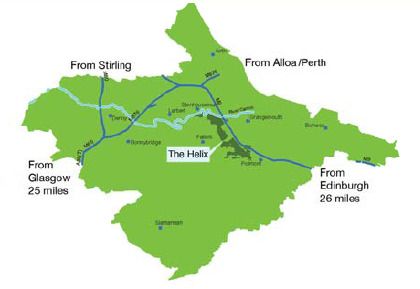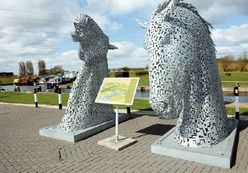The Helix is an ambitious environmental improvement project to transform under-used land between Falkirk and Grangemouth into a high quality greenspace. The first phase of the project, due to be completed in 2013, will create:
- a central park with a lagoon
- paths and cycle networks connecting local neighbourhoods
- new woodland areas
- a new canal link connecting Grangemouth and the Firth of Forth into Scotland’s extensive canal network
- the Kelpies™: two 30-metre high structures in the shape of horse’s heads
- public artworks
 The Helix site covers 300 hectares, an area equivalent to the size of 270 football pitches. The project is being driven by a partnership of Falkirk Council, British Waterways Scotland and Central Scotland Forest Trust through a body called the Helix Trust, which is committed to engaging the community in the design and encourages local people to participate in the creative process. The project has been awarded a £25 million grant from The Big Lottery Fund as part of its Living Landmarks Programme.
The Helix site covers 300 hectares, an area equivalent to the size of 270 football pitches. The project is being driven by a partnership of Falkirk Council, British Waterways Scotland and Central Scotland Forest Trust through a body called the Helix Trust, which is committed to engaging the community in the design and encourages local people to participate in the creative process. The project has been awarded a £25 million grant from The Big Lottery Fund as part of its Living Landmarks Programme.
In this article, Christian Barnes from Vista Projects, who is developing the project with landscape architect John Kennedy, describes how the Helix Trust has helped local people to take a lead role in the development of the Abbotshaugh Sentinel, a new earthwork that will be created within community woodland.
The Helix was one of 313 entrants for a one off Big Lottery grant of £25million. Our role was to contribute to the bid with a programme of community based public art/public realm proposals called ‘Sentinels’. We devised an approach in which we simply ignored the competition and imagined an ideal scenario of a design competition directed and led by an empowered community acting as its own client.
Rather than being ‘consulted’ about it after the appointments were made, the members of the client group would be responsible for the appointment and be supported in every way possible by us. The competition, rather than being a process in which competitors would finally meet the client after the winner had been declared, would instead be a recruitment process where relationships would be built to provide the foundation for an iterative design process within which local intelligence would be shared.
There is a sense of excitement as the appointment process now nears completion. We have been overwhelmed by the panel’s commitment to the project and the intelligence, fair-mindedness and diligence with which they have approached the project. It far surpasses anything we have seen in the professional sector. We have also been fortunate to find a committed partner in Grace McDonald, Head of Community Engagement, for the Helix Trust who has smoothed our way.
 We worked first to develop a brief for the project conceived as a landscape treatment/earthwork intended to catalyse renewed community engagement with the community green space known as Abbotshaugh woodland. The creative brief was drafted for, and amended by the community group. It emphasised place-making and community engagement and received more than 40 expressions of interest from a range of applicants from architectural firms (including a Stirling prize winner) to individual sculptors. The community panel poured over this material for hours, writing detailed comments and notes. It helped them to clarify their thinking about the woodland and the right approach for a creative intervention there.
We worked first to develop a brief for the project conceived as a landscape treatment/earthwork intended to catalyse renewed community engagement with the community green space known as Abbotshaugh woodland. The creative brief was drafted for, and amended by the community group. It emphasised place-making and community engagement and received more than 40 expressions of interest from a range of applicants from architectural firms (including a Stirling prize winner) to individual sculptors. The community panel poured over this material for hours, writing detailed comments and notes. It helped them to clarify their thinking about the woodland and the right approach for a creative intervention there.
In June it was decided which five artists would be offered honoraria to participate in a charette held in the woodland and in the nearby Dawson Centre on David’s Loan. The interviews/charette were conducted over a two day period in July, preceded by briefings and tours of the Helix area. The panel led a walking tour of the area in the Abbotshaugh woodland and around the local community. The day provided a good opportunity for the artists to absorb the thinking of panelists and community members and for community members to meet and discuss ideas with the artists.
The following day the charettes were broken into two sessions which allowed for five and a half hours of unprepared discussion followed by an interview, led by the community panel. During the charette the public were admitted and free to become involved. We met again in August to confirm the panel’s preferences and we are waiting now for formal processes to be completed for the Helix to confirm an appointment in September.
When we started work on the project we had the luxury of imagining an ideal project where a community would take responsibility and control of an aspect of its own cultural regeneration. The project and the panel has filled us with new optimism and hopefully established a new approach to the public commissioning of artists that can be adopted elsewhere.
